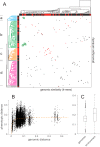The Pseudomonas aeruginosa Transcriptional Landscape Is Shaped by Environmental Heterogeneity and Genetic Variation
- PMID: 26126853
- PMCID: PMC4488947
- DOI: 10.1128/mBio.00749-15
The Pseudomonas aeruginosa Transcriptional Landscape Is Shaped by Environmental Heterogeneity and Genetic Variation
Abstract
Phenotypic variability among bacteria depends on gene expression in response to different environments, and it also reflects differences in genomic structure. In this study, we analyzed transcriptome sequencing (RNA-seq) profiles of 151 Pseudomonas aeruginosa clinical isolates under standard laboratory conditions and of one P. aeruginosa type strain under 14 different environmental conditions. Our approach allowed dissection of the impact of the genetic background versus environmental cues on P. aeruginosa gene expression profiles and revealed that phenotypic variation was larger in response to changing environments than between genomically different isolates. We demonstrate that mutations within the global regulator LasR affect more than one trait (pleiotropy) and that the interaction between mutations (epistasis) shapes the P. aeruginosa phenotypic plasticity landscape. Because of pleiotropic and epistatic effects, average genotype and phenotype measures appeared to be uncorrelated in P. aeruginosa.
Importance: This work links experimental data of unprecedented complexity with evolution theory and delineates the transcriptional landscape of the opportunistic pathogen Pseudomonas aeruginosa. We found that gene expression profiles are most strongly influenced by environmental cues, while at the same time the transcriptional profiles were also shaped considerably by genetic variation within global regulators. The comprehensive set of transcriptomic and genomic data of more than 150 clinical P. aeruginosa isolates will be made publically accessible to all researchers via a dedicated web interface. Both Pseudomonas specialists interested in expression and regulation of specific genes and researchers from other fields with more global interest in the phenotypic and genotypic variation of this important model species can access all information on various levels of detail.
Copyright © 2015 Dötsch et al.
Figures





References
Publication types
MeSH terms
Associated data
- Actions
- SRA/SRP034661
- SRA/SRP036144
LinkOut - more resources
Full Text Sources
Molecular Biology Databases
